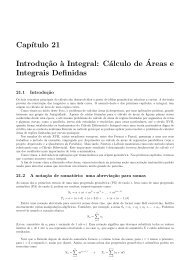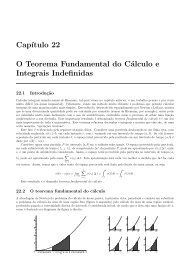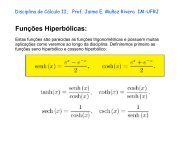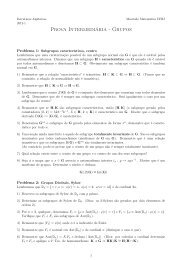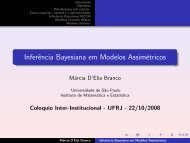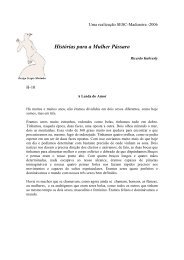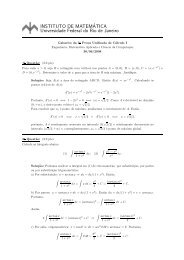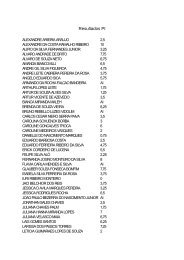Primeiro Complemento de aula
Primeiro Complemento de aula
Primeiro Complemento de aula
Create successful ePaper yourself
Turn your PDF publications into a flip-book with our unique Google optimized e-Paper software.
30 Capítulo 2. Espaços <strong>de</strong> Banach<br />
• p(λx) = λp(x), ∀x ∈ E, ∀λ > 0<br />
• p(x + y) ≤ p(x) + p(y), ∀x, y ∈ E<br />
Denotemos por G um subespaço <strong>de</strong> E e g : G → R uma aplicação linear tal que<br />
g(x) ≤ p(x), ∀x ∈ G<br />
Então existe uma forma linear f : E → R satisfazendo<br />
e ainda<br />
g(x) = f(x), ∀x ∈ G<br />
f(x) ≤ p(x) ∀x ∈ E<br />
Demonstração.- Seja E um espaço normado e G um subespaço <strong>de</strong> E. Se G = E,<br />
então existe um elemento x0 ∈ E e x0 /∈ G. Definimos assim o espaço G1 = G + Rx0.<br />
Mostraremos que f po<strong>de</strong> ser estendido a G1 satisfazendo<br />
Denotemos por f1 a extensão <strong>de</strong> f dada por<br />
f(x) ≤ p(x), ∀x ∈ G1 (2.3)<br />
f1(x + tx0) = f(x) + tα<br />
On<strong>de</strong> α será escolhida posteriormente <strong>de</strong> tal forma que verifique a <strong>de</strong>sigualda<strong>de</strong> 2.3.<br />
Isto é que se verifique que<br />
f1(x + tx0) ≤ p(x + tx0)<br />
Ou equivalentemente, para t > 0<br />
f1( x<br />
t + x0) ≤ p( x<br />
t + x0), ou f1( x<br />
t − x0) ≤ p( x<br />
− x0)<br />
t<br />
Isto é equivalente a mostrar que<br />
De on<strong>de</strong> obtemos que<br />
f1(y + x0) ≤ p(y + x0), f1(y − x0) ≤ p(y − x0) ∀y ∈ G<br />
f(y) + α ≤ p(y + x0), f(y) − α ≤ p(y − x0) ∀y ∈ G<br />
Por outro lado, para x, y ∈ G e da <strong>de</strong>sigualda<strong>de</strong> triangular temos<br />
De on<strong>de</strong> segue que<br />
f(x + y) ≤ p(x + y) ≤ p(x + x0) + p(y − x0).<br />
f(y) − p(y − x0) ≤ p(x + x0) − f(x)




